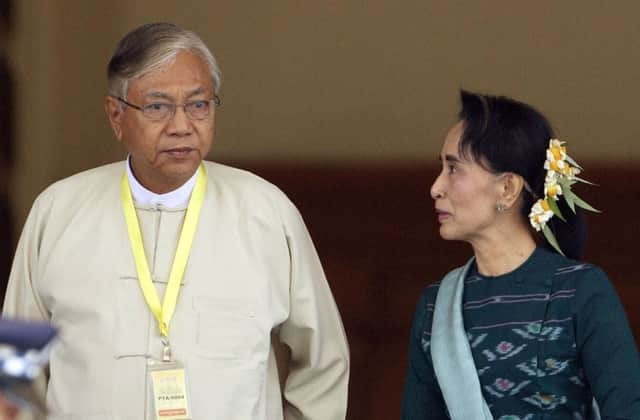Aung San Suu Kyi on list of Burma cabinet members


President-elect Htin Kyaw submitted the names to parliament for a formal review and approval by legislators today, after which the ministers’ cabinet positions will be decided.
At the top of the list is Ms Suu Kyi, who was not able to become president for legal reasons, even though she led her party to a landslide victory in a general election last November.
Advertisement
Hide AdAdvertisement
Hide AdIt has been widely rumoured that Ms Suu Kyi will become foreign minister, but that is far from certain because if she were to take the role she would have to give up her parliamentary seat and end party activities.
“I doubt that Aung San Suu Kyi would take the position of the foreign minister,” said Toe Kyaw Hlaign, a political analyst.
“She will have to do a lot of international relations and overseas trips, and she won’t have the time to exercise control over the government.”
Ms Suu Kyi has said previously that she would be “above the president” and govern the country indirectly.
Still, her entry into the government is a remarkable change. For decades the junta kept Burma in isolation and economic stagnation while refusing to listen to international counsel or homegrown demands for democracy.
Ms Suu Kyi came to prominence in 1988 when popular protests were building up. The junta crushed the protests that had turned into anti-government riots, killing thousands of people and placing Ms Suu Kyi under house arrest in 1989.
The junta called elections in 1990 but refused to hand over power when Ms Suu Kyi’s National League for Democracy party won overwhelmingly. She was awarded the Nobel Peace Prize a year later.
As Burma continued to wallow under military rule, Ms Suu Kyi was released and re-arrested several times.
Advertisement
Hide AdAdvertisement
Hide AdThe junta finally started loosening its grip on power in 2010, allowing elections that were won by a military-allied party after the NLD boycotted the polls as unfair.
After more reforms, another general election was held last November, with the NLD winning a sweeping victory – a reflection of Ms Suu Kyi’s widespread public support.
The win came five years to the day since she was released from 15 years of house arrest.
However, a constitutional clause excludes anyone from the presidency who has a foreign spouse or children – Ms Suu Kyi’s two sons are British, as was her late husband. The clause is widely seen as having been written by the military with her in mind.
The democracy that Ms Suu Kyi and her colleagues are building is still not a complete package. The military has reserved 25 per cent of the seats in parliament for itself, guaranteeing that no government can amend the constitution without its approval.
Also, it ensured that one of Htin Kyaw’s two vice-presidents is a former general. Myint Swe was a close ally of former junta leader Than Shwe, and is on a US Treasury Department blacklist that bars American companies from doing business with figures connected with the former junta.